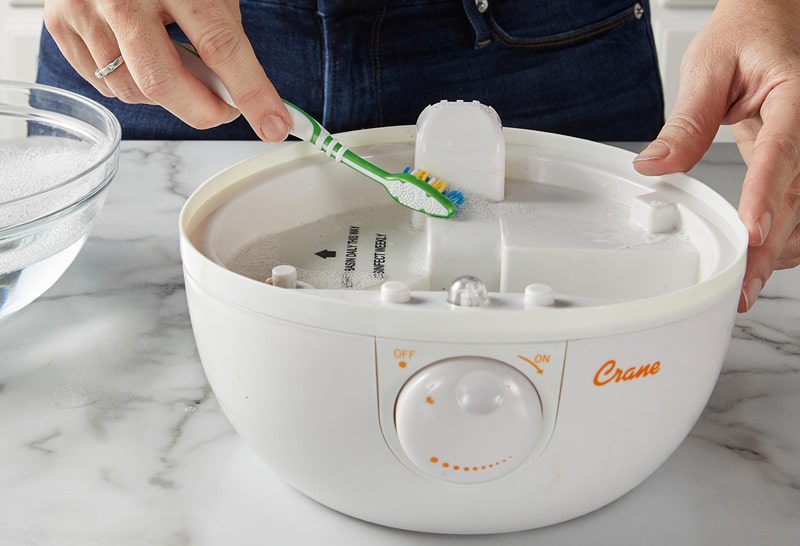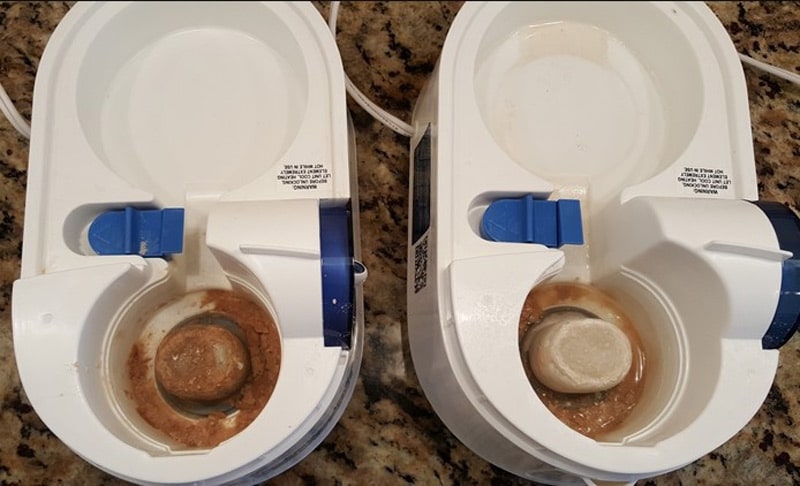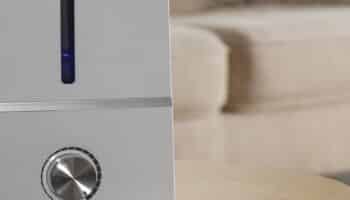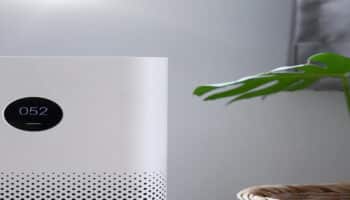Humidifiers can be a wonderful addition to your home, particularly in a room where you spend a lot of time. If you live in a cold or very dry climate, they’re almost a requirement to maintain a normal quality of life.
When you think about it, they really are simple machines that make life more comfortable simply by taking water and turning into humidity and dispersing it where you need it.
By doing this, the inflammation from allergens are reduced, relief from physical ailments like respiratory issues or dry skin is provided, and the purity of the air being breathed is improved.
But there’s a flipside to all of those positivies. A dark side. Yes, it’s time to talk about mold!
Okay, that’s a bit of an exaggeration. Didn’t mean to make it sound like a horror movie. But if you’ve ever dealt with mold, you know not only does it smell bad and look terrible, it does actually affect your health in ways no one wants to experience if avoidable.
The last thing you want is the one machine you bought to improve your health suddenly starts working against you.
So, yes, moisture can indeed lead to mold. At the same time moisture’s an absolute necessity for humidifiers to work properly.
As a result, there are five steps you can take to prevent and fight off mold in your humidifier and thereby keep it from becoming a mold dispenser.
The Best Way to Prevent Mold
Let’s start with the best way to prevent mold in your humidifier. Ready?
That’s really what it boils down to. Sorry if it doesn’t sound magical but that’s all there is to it. Now, of course, cleaning does entail more specifics but getting to the crux of the matter, it’s all about cleanliness.
Think of the things in your home that routinely use water and routinely require continuous cleaning. Sinks. Showers and bathtubs. Toilets.
Pretty standard stuff, right? And if you don’t clean them, what happens?
Scum, scale, mildew, mold, etc.
If you’ve got water filtration systems for drinking water or an ice maker, you’ve also got filters that help clean out the contaminants to prevent that same type stuff prior to consumption.
With humidifiers, you may have filters but you also may not. Depends on the humidifier. Even if you do have filters, they don’t last forever and require replacement.
What you will always have, though, is water.
Where there is water there is potential for scum, scale, mildew, and mold.
The easiest way to prevent that kind of stuff is through cleaning.
So, what to clean?

Try This 4 Simple Steps:
1. The Water Tank and Well (Base)
Well, the first place to start is the place where the most water is collected on the humidifier. That, of course, is the water tank and the well (or base) the tank rests on.
If you’re not using your humidifier, it should never have standing water left in it. In fact, even if you’re leaving for work during the day, empty the tank and let it air-dry at the minimum.
Before you use your humidifier, dump any older water out of the tank and rinse it out with warm water. This should be done daily during continuous operation.
Some people use a warm water and soapy mixture. Ultimately, you should follow what your manufacturer recommends. A warm water and soapy mixture won’t hurt but if you don’t’ rinse the tank well enough, you could have residual soap left behind.
A better mixture might be warm water and white vinegar. Vinegar acts as a natural disinfectant and anti-microbial. It also won’t leave a residue like soap.
Some people might find the odor of vinegar off putting if used all the time. If rinsed thoroughly, though, no lingering smell should remain. Some people, however, are more sensitive than others.
If you choose to use warm water and vinegar, pour a cup of each into the tank and let it soak for about twenty minutes. While letting it soak, you can work on the well.
For the well, or base, rinse with warm water and either soap or vinegar. In addition, clean out any crevices of scale or grime you might see. A dedicated tooth brush or Q-tips work well.
After cleaning the tank and well, towel dry and put to use. The whole procedure shouldn’t take more than 30 minutes and will be the biggest preventer to mold development.
2. Disinfect Your Humidifier
While running the humidifier, you can add up to a cup of vinegar to the water or a specific type of humidifier tablets that do the same job and don’t have the smell of vinegar. Either will help keep other parts of the humidifier exposed to moisture clean and ensure the mist being introduced into your home is free from microbes and mold spores.
Some people even go so far as to recommend mixing a small out of bleach with the water during operation. Don’t do this.
Why?
Running bleach through your humidifier’s system on a regular or frequent basis can have a damaging effect, especially to plastic parts and rubber gaskets. In addition, the smell of bleach can be overpowering.
Yes, you can use bleach to disinfect your humidifier. However, the bleach solution should be kept to the tank only. Don’t run the humidifier and only let the bleach solution sit in the tank for about 15 minutes. Thoroughly rinse the tank before resuming normal operations.
To disinfect other parts of your humidifier, you can again use a water and vinegar mixture or hydrogen peroxide. The peroxide is great for hitting all the exposed surfaces, especially plastic, which can be porous.
Disinfecting is similar to daily cleaning only you’re going to be more thorough and hit as many parts as you can. This is also a good time to inspect your filter if you have one and replace it as necessary.
Again, clean your tank and well daily. During regular use, you should aim to disinfect weekly. You should avoid going more than ten days between disinfecting, even when running vinegar with your water routinely.
3. If Mold is Present
If you’ve found mold or suspect mold in your humidifier, it’s time to use some bleach.
Yes, you were told to avoid using bleach mixed with water during normal operation. That remains true. However, if you’re target is mold that may already exist, well, this isn’t a normal operation anymore.
First, move your humidifier outside to do this work. You don’t want to use bleach and run a humidifier indoors if you can avoid it.
You’ll also need to operate the humidifier outside, so make sure you set up near an outlet or have an extension cord handy if you need it.
Besides doing a normal disinfection, you’re going to do the 15 minute bleach soak in the tank. After that, run the bleach and water through the humidifier for no more than 30 minutes.
Dump and rinse the tank thoroughly. Refill with normal water and run again, probably no more than another 30 minutes. This will ensure the internal components of the humidifier are cleared of any leftover bleach.
Lastly, if you have a filter, put a new one in.
Let the entire humidifier air dry, preferably while exposed to sunlight.
You can also do this level of mold destruction/prevention if you’re pulling your humidifier out of seasonal storage. Remember, though, this isn’t routine maintenance. If you follow the simple daily cleaning and weekly disinfecting schedule, you can pretty much avoid this level of cleaning.

4. When to Call for Help
If you can’t win the mold fight, it may not be anything you are or aren’t doing. Sometimes, humidifiers need some professional help. Or they need replacement. Don’t drive yourself crazy if you’re fighting a losing battle. Call a technician or service center and get a professional opinion.
Conclusion
With a humidifier comes cleaning. There’s no way of avoiding it. If you do avoid it, you’ll not only have a humidifier that starts to degrade and work less efficiently over time, you’ll have a humidifier that may become overrun with scale and, worst case, mold. To avoid mold, and the terrible smell and possible health issues that come with it, all you have to do is keep your humidifier clean and disinfected. Doing this will maintain your humidifier in good working order and avoid any negative impact on your health and your home.







